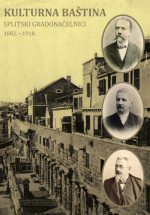Dr. Vicko Vice Mihaljević
Dr Vicko Vice Mihaljević
Author(s): Hania Mladineo MikaSubject(s): Poetry, Governance, Local History / Microhistory, Political history, Croatian Literature, 19th Century, Pre-WW I & WW I (1900 -1919)
Published by: DRUŠTVO PRIJATELJA KULTURNE BAŠTINE - SPLIT
Keywords: dr Vicko Mihaljević; mayor; Croatian poet; Split; Marjan; Slatine; Muć; Lećevica; Drniš; 19th and 20th century;
Summary/Abstract: Vicko Josip, Juraj Mihaljević and Domina Dujmović’s son, was born in Split on April 5th 1861. He finished both elementary and grammar school in Split and graduated from law school in Graz. After he returned to Split in 1884, he became active in politics. In the following year, however, he was offered a secretarial post in the Split Municipality by Gajo Bulat. He resigned from this post in 1891 to apply for the bar exam and start practising law. He married Tereza Lovrić in 1898, who was the daughter of tradesman Pavle Lovrić and Ana Školjan. As a politican, he supported and eventually joined the new Party of Rights whose chairman was Ante Trumbić. Vicko Mihaljević left his mark in the Croatian literature as a poet. He published poetry under the pseudonym of Neurastenicus. He created a number of humorous and patriotic poems, that, in 1900, were published in the two collections: Na uztuk and Pregršt šušnja. V. Mihaljević was a representative in the Diet of Dalmatia. He was also a manager of a number of firms and head of the Split branch of Ljubljanska banka. He was at the helm of various associations, such as Hrvatski dom (Croatian Lodge) and Za Split (For Split). In addition, he was a board member of the so-called Hrvatski sokol and participated in board elections for association Bihać. He was a man of many hats – although a lawyer, he was interested in mining and crafts. He was appointed Mayor on 11th June 1907. He held office for four years, that is, until sudden death. Many positive changes occured in the course of his tenure. Public roads in both the central and greater area of Split were constructed; school buildings were built and for that very purpose, the Municipality either acquired or rented plots of land. The construction of the Croatian Lodge was completed in January 1908. Since its main hall was yet to be completed, a charity ball was held in the Theatre to raise funds for its construction. Finally, the hall was opened on 13th September, in the presence of many distinguished guests, such as the mayor himself, Frane Bulić, et al. He died of stroke at home, at the age of 50, on 25th June 1911. He was buried three days later at Sustipan cemetery. A renowned sculptor, Ivan Rendić, designed his tombstone – an allegorical sculpture named Meditation. The citizens of Split were shocked by the sudden death of the mayor and thus decided to arrange a majestic funeral. The article published in his honour in the newspaper Naše jedinstvo read: Dr V. Mihaljević lived for his people and his town. He is therefore mourned today and will be mourned wherever there are those who had honour to know him and wherever there are Croatians. May God bless his soul! However, in the following year, in the section Gradski vjesnik of the same newspaper, the article was published that read: It has been a year since our dear mayor, Dr Vice Mihaljević, passed away, but noone seems to remeber him anymore. His wife Tereza inherited both his assets and liabilities.
Journal: KULTURNA BAŠTINA : ČASOPIS ZA PITANJA PROŠLOSTI SPLITSKOGA PODRUČJA
- Issue Year: 2018
- Issue No: 44
- Page Range: 173-200
- Page Count: 28
- Language: Croatian

